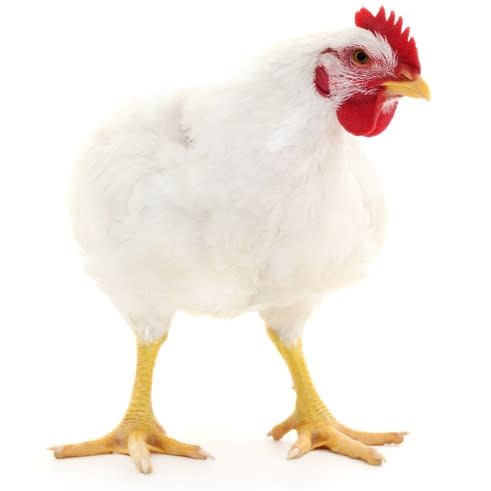Like all chickens raised for meat on factory farms—she had no choice but to desperately eat as much, and as often as she could. She was genetically designed by humans to grow so large, so fast, so that she could be killed and sold as fast as possible.
The Life of a Broiler Chicken
When we think about smart, curious, compassionate animals, chances are a dog or cat comes to mind. But what if we shared our homes with playful chickens? Chances are, we’d begin to see them not as food, but as friends. As beloved, smart, cuddly companions.
Katie's Story
Meet Katie. Katie began her life like nearly every other chicken raised for meat. Alone and scared, despite being surrounded by thousands of other chicks. Like all babies, she needed the comfort and care of her mom and dad. But they were nowhere in sight—left on the farm where she was laid as an egg.

Her first days
Within hours of blinking her eyes open, Katie was covered in a cocktail of vaccines and flung into a crate, destined to her forever home—a factory farm. Hungry. Thirsty. Cold. And still scared.
As she tumbled out of her crate and into the barn she tried to find her footing. Despite the shocking bright lights and chicks all around her, Katie couldn’t help but frantically search for food and water.

Katie was nothing more than a product
Her only purpose was to make big companies money. Her life would be dictated by humans every step of the way. From the farmer who raised her, to a corporate slaughterhouse who would kill her, to a distributor and then a supermarket who would put her on a dinner plate.
Even Though Katie Is A Lot Like Us
Her First Few Weeks
Katie watched as her fellow chicks got sick and died in agony
Katie and her companions were mere babies
Destined to be killed for food after just 6-7 weeks of life. When this day would come, Katie would be picked up by one of her frail legs, tossed into a tightly-packed crate, and trucked to her tragic death—hungry and stressed. Within the slaughterhouse, she’d be hung upside down by her legs with painful metal shackles. Unable to fully breathe. She’d then be whisked into an electric water bath to be stunned into unconsciousness—though this likely wouldn't happen. Instead, in sheer fear and panic, she might flap her wings or move her head, and miss this step. Either way, she’d be killed—conscious or unconscious—by an automated knife to her throat. Katie would be one of the 140 chickens killed every minute in a US slaughterhouse. Just a number on a corporate balance sheet. Yet, like our beloved dogs and cats, she would feel every bit of this brutal pain.
But before that day came
Just when giving up felt like the only option, the giant barn doors opened. A foot, covered in feces, stepped next to her. A kind woman’s face leaned close to hers. Katie could feel her breathe. Before she could take it all in, two gentle hands wrapped around her. The next thing Katie knew, she was nestled in a car with other chickens like her.
The volunteer rescuers—who had been called to save Katie and her companions after the factory farm had gone bankrupt—wept in grief.
Nothing could have prepared them for what they just experienced. As they walked through the ravaged barn thousands of chickens were dying around them, battered and in pain. Others had already passed. In the end, they rescued 436 chickens. Katie was one.
Her last few months
Katie spent the next few days being cared for and rehabilitated in her first-ever loving home, at Luvin Arms Sanctuary. As her wounds healed, and she regained strength, she took the final trip of her life with five others to Changing Hearts Farm, a sanctuary in North Carolina, where she was welcomed with open arms by her new human friends. Here, Katie would live out the rest of her short life. Ultimately, her organs could not support her overgrown body—meant to survive for a handful of weeks. She died at just six months of age.
In that six-month period she experienced the worst of humanity—all behind the closed, obscure doors of factory farms. Far from the public eye. Katie was one of an estimated 9 billion broiler chickens raised and killed for food each year in the US.
Katie's rescue story is not the norm
Unlike nearly every other chicken raised for meat, Katie also experienced a glimpse into the best of humanity. The love that is felt when one person cares enough to take a stand for another.
You can be that person for each and every chicken who is sad, scared, and abused right now on a factory farm. Just like Katie was. And you don’t need to step into a factory farm to be the change.
Help Chickens Like Katie
You can start by repairing our broken food system that held Katie captive and ultimately took her life.
Photo credits
Images are representative of typical factory farms and do not necessarily depict exact conditions being described
- Hero image: Adam Peditto at Changing Hearts Farm
- Image of broiler chicken in shed: Andrew Skowron/Open Cages
- Images of chickens suffering "Katie watched as her...": Andrew Skowron/Open Cages
Want to dig deeper? Here's a full list of sources for each of the facts you've read above.